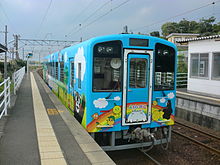Kumamon


Kumamon (くまモン) is a mascot created by the government of Kumamoto Prefecture, Japan. It was created in 2010 for a campaign created to draw tourists to the region after the Kyushu Shinkansen line opened.[1] Kumamon subsequently became nationally popular, and in late 2011, was voted top in a nationwide survey of mascots, collectively known as yuru-chara, garnering over 280,000 votes.[2][3] Following his success in the contest, Kumamoto earned ¥11.8 billion (US$120 million, £79 million, €93 million) in merchandising revenue for the first half of 2012, after having only earned ¥2.5 billion (US$26 million, £17 million, €20 million) throughout all of 2011.[4][5] Kumamon enjoys tremendous popularity throughout the world.[6]
Economic impact[edit]
In just two years, Kumamon has generated US$1.2 billion in economic benefits for his region, including tourism and product sales, as well as US$90 million worth of publicity, according to a recent Bank of Japan study.[7] Sales of Kumamon items have reached ¥29.3 billion in 2012, up from ¥2.5 billion in 2011.[8]

The Bank of Japan also estimated that Kumamon generated ¥123.2 billion in revenue during a two-year period starting from 2011.[6]
Success[edit]
A large part of Kumamon's success can be attributed to its cuteness.[8] The unusual marketing strategy of free licensing is also behind Kumamon's commercial success,[8] since the Kumamoto prefecture grants usage rights for free to anyone as long as their products promote goods and services from the prefecture.[6][8] Furthermore, in 2018, the Kumamoto prefecture decided to allow foreign businesses to use Kumamon, aiming to expand Kumamon to the world.[9]
Cultural impact[edit]
This mascot has a minor cameo in the 2014 video game Yo-Kai Watch 2, and made an appearance in Yo-kai Watch: The Movie, following the main characters (Whisper, Nate, and Jibanyan) around. It also gained internet popularity when images of Kumamon, usually around large fires, were captioned with "Why? For the glory of Satan, of course!".[10] The Kumamoto Prefecture has taken this well, but has more carefully restricted official photography of the mascot.

Since 3 September 2018, Kumamon has embraced a new identity as a YouTuber.[11] Videos in Japanese have been uploaded onto its YouTube account every Monday.[12]
Retail sales[edit]
| Year(s) | Retail sales | Ref | |
|---|---|---|---|
| Japanese yen | US dollars | ||
| 2011–2013 | ¥133,400,000,000 | $1,367,000,000 | [13][14] |
| 2014 | ¥64,320,000,000 | $607,109,000 | [15] |
| 2015 | ¥100,700,000,000 | $925,612,000 | [16] |
| 2016 | ¥128,022,690,000 | $1,176,756,000 | [17] |
| 2017 | ¥140,874,200,000 | $1,255,942,000 | [18] |
| 2018 | ¥150,556,550,000 | $1,363,451,000 | [19] |
| 2019 | ¥157,955,570,000 | $1,449,005,000 | [20] |
| 2011–2019 | ¥875,829,010,000 | $8,159,549,000 | |
See also[edit]
References[edit]
- ^ "Top Ten Japanese Character Mascots". Finding Fukuoka. 2012-01-13. Retrieved 2013-02-16.
- ^ "Japan's #1 Mascots: Kumamon, Bary-san, and Nishiko-kun". Japan Probe. 2011-11-28. Archived from the original on 2013-06-21. Retrieved 2013-02-16.
- ^ "Kumamoto Mascot "Kuma-mon" Won First Prize | Tenkai-japan:Cool Japan Guide-Travel, Shopping, Fashion, J-pop". Tenkai-japan. Retrieved 2013-02-16.
- ^ Brasor, Philip (2013-01-13). "Mascots bear cash for local authorities". The Japan Times. Retrieved 2013-02-16.
- ^ Wakabayashi, Daisuke (2012-12-25). "Isn't That Cute? In Japan, Cuddly Characters Compete - WSJ.com". Online.wsj.com. Retrieved 2013-02-16.
- ^ a b c Brasor, Philip (2014-04-15). "Can a solo career help a mascot stand out?". The Japan Times. Retrieved 2014-04-20.
- ^ "Cuddly bear Kumamon becomes a marketing superstar in Japan". South China Morning Post. February 24, 2014. Retrieved 2017-07-27.
- ^ a b c d Fuji, Moeko (Jun 28, 2013). "The Branding of Kumamon: The Bear That Stole Japan's Heart". The Wall Street Journal. Retrieved 6 May 2015.
- ^ "Kumamoto Prefecture decides to allow foreign firms to use its Kumamon bear brand". The Japan Times. 4 January 2018. Archived from the original on 2018-01-04. Retrieved 2022-07-30.
- ^ Ashcraft, Brian (1 March 2016). "Osaka Overrun For The Glory Of Satan, Of Course!". Kotaku Australia. Surrey Hills, Australia: Pedestrian Group. Retrieved 7 January 2021.
- ^ "1-й эпизод Kumamon TV" (in Japanese). YouTube. 3 September 2018. Retrieved 17 March 2021.
- ^ "Iconic Japanese mascot Kumamon to become YouTuber". The Japan Times. 22 August 2018. Retrieved 17 March 2021.
- ^ "Demon Slayer Economic Impact Estimated at 270 B. Yen". Nippon.com. Nippon Communications Foundation. December 4, 2020. Retrieved December 6, 2020.
- ^ "'Demon Slayer' economic impact estimated at ¥270 billion". The Japan Times. December 5, 2020. Retrieved December 6, 2020.
- ^ "くまモン商品の売り上げ643億円超えたモン". Sankei Shimbun (in Japanese). 2015-03-08. Archived from the original on 2015-05-11. Retrieved 25 January 2021.
- ^ "Kumamon product sales top ¥100 billion in 2015 for first time". Japan Times. March 3, 2016.
- ^ "くまモン商品売上高1280億円 16年、過去最高 復興応援機運高まる". Nishinippon Shimbun (in Japanese). 2017-02-15. Archived from the original on 2017-02-15. Retrieved 25 January 2021.
- ^ "くまモン売上1408億円 17年、過去最高更新 海外で倍増". Nishinippon Shimbun (in Japanese). 2018-03-20. Retrieved 22 February 2020.
- ^ "くまモン売上高、初の1500億円突破 海外解禁が後押し". Nishinippon Shimbun (in Japanese). 2019-03-05. Retrieved 22 February 2020.
- ^ "くまモン商品、19年売上高は1579億円 8年連続最高". 熊本日日新聞 (in Japanese). Kyodo News. 29 February 2020. Archived from the original on 2020-03-13. Retrieved 25 January 2021.
External links[edit]
- Official website (in Japanese)
- Kumamon on Twitter (in Japanese)
- KumamonTV's channel on YouTube
- Kumamon on Facebook (in Japanese)
